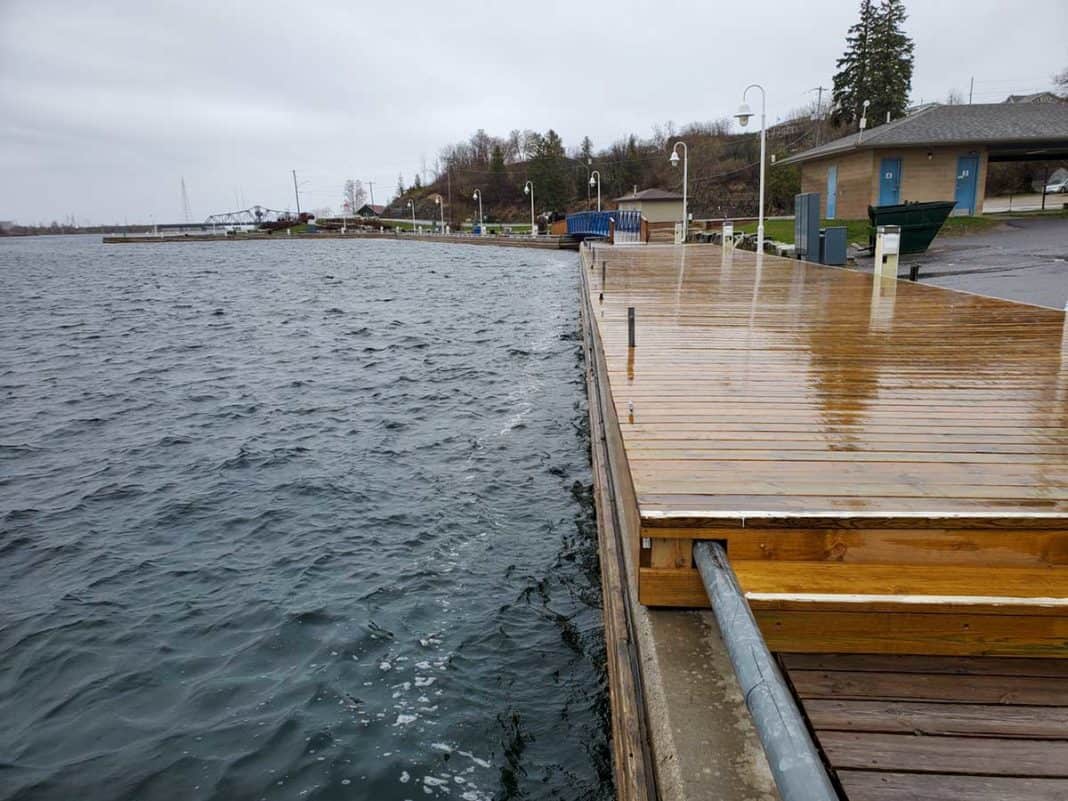MANITOULIN – Water levels in Lakes Huron/Michigan are 14 inches (about 35 centimetres) below levels from the same time last year, according to an April 23 forecast from US Army Corps of Engineers (USACE), though they remain 22 inches (56 centimetres) above the long-term average for April.
“(Water levels have) really been going down. In a typical year, we’d see a 30 centimetre drop between the highs of summer and the lows of spring in the Great Lakes … this year we saw a drop of 50 centimetres,” said Frank Seglenieks, water resources engineer at Environment Canada.
Many Islanders have noted a marked decline in water levels this spring, which set records last April for having the highest monthly average water level, according to USACE data. Water levels in Michigan/Huron are 37 inches or about three feet above navigational chart data.
Water levels held steady between March and April at 580.54 feet above sea level, and levels are projected to rise two inches in the two lakes by May 23.
Weather temperatures for the Great Lakes basin have been close to slightly below average for this time of year over the past two weeks, though month-to-date precipitation accumulation was only between 55 and 71 percent of the average level near most of the Great Lakes. Lake Superior, however, recorded 54 percent more precipitation accumulation than normal for the month to date as of the reported data on April 23.
All of the Great Lakes are above their long-term averages except for Lake Ontario, which is nine inches (23 centimetres) below its long-term mean, though it has gone up nine inches compared to the prior month.
When compared with 2020, lake levels have dropped five inches (13 cm) on Lake Superior, 28 inches (71 cm) on Lake Ontario, 13 inches (33 cm) on Lakes Huron/Michigan, 15 inches (38 cm) on Lake St. Clair and 17 inches (43 cm) on Lake Erie.
Water flowing into Lakes Huron/Michigan from Lake Superior, via the St. Mary’s River, is expected to be average for April, though the outflow of Lakes Huron/Michigan into Lake Erie via the St. Clair River is forecast to be above average.
Above-average water transfer between the lower Great Lakes continues all the way into the St. Lawrence River.
USACE predicted high water levels to continue for at least six months and it advised flood-prone areas to continue to expect such conditions.
According to data charts from Environment Canada, water levels follow a cyclical pattern and tend to reach their lowest point each year around March. The chart for Lake Huron/Michigan shows a steady drop from July 2020 until March 2021, with a much lower drop than March of last year.
Mr. Seglenieks said it was still unclear whether the drop had bottomed out before the annual rise in the summer, as final April average numbers were not available when he spoke with The Expositor, but said it appeared levels were beginning to rebound from the winter.
This past relatively mild winter was also fairly dry in terms of precipitation, which was a significant contributor to the marked decrease in water levels. In the Lake Ontario basin, the past 12 months have been the driest on record since the 1950s, though the Lake Huron/Michigan is not quite at record lows.
Forecasting water conditions
Environment Canada’s charts show a forecast until September 2021, which illustrates a maximum and minimum forecast water level range. If the actual water levels follow the higher end of the forecast, they will remain roughly 15 centimetres below last year’s levels. At the low end of the forecast (during a particularly dry season, for instance), water levels will remain close to their current depths until the seasonal drop begins in July, which would be roughly 45 centimetres below last summer’s levels.
When comparing the long-term average, Environment Canada’s charts show this summer’s forecast levels as being between 40 and 70 centimetres above the long-term average of the lake.
This is largely a product of current water levels already being far below last year’s starting point, meaning even an extreme-wet warm season would not be able to make up the deficit.
Mr. Seglenieks is careful to note that even though water levels are so much lower this year, they still remain well above the average.
“Even if we continue these relatively dry conditions, we’re probably not going to get back down to the average levels this season,” he said, “and we wouldn’t even get to the same heights as we got last year.”
Environment Canada’s long-term forecast models incorporate data from 1918 to present. The lowest lake levels on record in Lakes Huron/Michigan was 1964, except for a record low for December set in 2012 and a record low for January set in 2013.
2020’s water levels set records from January through August, with 1986 remaining the highest water for the months of September through December.
Forecasting water levels in the Great Lakes is notoriously difficult because their massive size and complicated watersheds mean there are umpteen factors that all have an effect on the conditions at the lake level.
The forecasted range between a high and a low estimate of where the levels would be gets rather wide even six months out from the current day, and would get much wider if using a longer time horizon.
“As an example, in 2018 when levels were just above average, we could have never predicted that we’d be breaking records three years later,” Mr. Seglenieks said.
People living near the shoreline should take heed that water levels are still much higher than average and, under certain weather conditions, potentially catastrophic flooding is still a risk.
“Don’t be lulled into a false sense of security that we are almost 40 centimetres lower than last year, because we hit records last year. The water levels are still very high and can be damaging if we get storms and big waves on top of the average water levels. Still be cautious,” Mr. Seglenieks said. “The levels are high enough that we could still see some flooding and erosion damage.”





